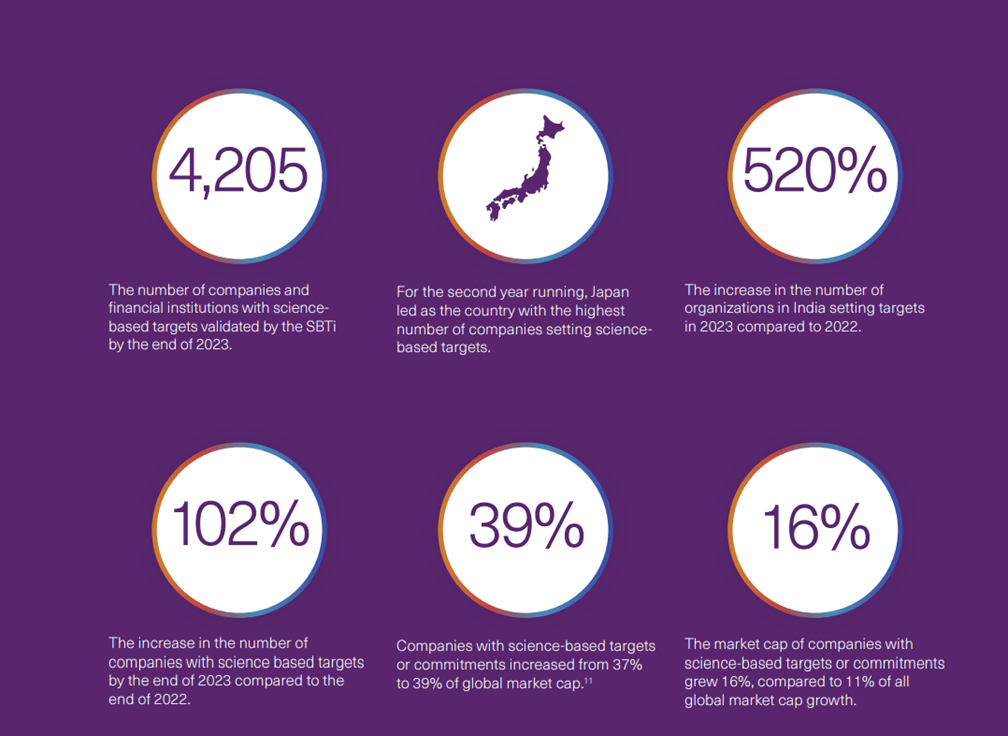As we approach this holiday season, we recognize there are a number of challenges in the corporate sustainability movement today, but there is also great momentum in a number of areas. Success stories about positive progress in corporate sustainability initiatives are continuing to proliferate, providing clear case studies for other companies to follow. Companies can learn from successful sustainability initiatives by recognizing the potential for enhanced brand reputation, improved financial performance, and positive social and environmental impact. There are many paths for companies to follow in their sustainability journeys, all of which are influenced by a number of macro trends shaping market development, and 10 of the bright spots in corporate sustainability that we are watching closely at Canopy Edge are outlined below.
Science-Based Targets for GHG Emissions Reduction
The number of companies signing on to science-based targets for greenhouse gas (GHG) emissions reduction is continuing to increase at a healthy pace. The Science Based Targets initiative (SBTi) is a partnership between the Carbon Disclosure Project (CDP), the United Nations Global Compact, World Resources Institute (WRI) and the World Wide Fund for Nature (WWF). SBTi helps companies set science-based targets to reduce their GHG emissions. As of September 2023, more than 4,200 companies and financial institutions have set science-based targets, a number that has continued to increase at a rapid pace in the past couple of years. Some of the most well-known companies that have set science-based targets include Apple, Google, Ford, General Motors, and PepsiCo.

2025 Brings Clarity to Climate Disclosure Requirements
2025 will bring clarity and certainty to open questions about climate disclosure and compliance requirements including the SEC reporting rules and California SB 253 and 261. California has been a pioneer in climate disclosure, and 2025 marks a key milestone for compliance with its SB 253 law. The SEC’s new climate disclosure rules, announced in March 2024, would require public companies to disclose material climate-related risks in their SEC filings. Those rules may be modified significantly or perhaps shelved entirely with the incoming Trump administration, but many of the subject companies will face similar requirements under other regulatory frameworks.
In addition, there are meaningful legislative initiatives underway in several states, including Illinois, Minnesota, New York, and Washington, the outcome and implications of which will become more clear in the coming months. And on a broader level, with the first reporting deadline for the European Union’s Corporate Sustainability Reporting Directive (CSRD) being just months away, and the transitional phase for the EU’s Carbon Border Adjustment Mechanism (CBAM) continuing through 2025 before entering the full operational period in January 2026, best practices for EU-driven carbon disclosures will come into much greater focus during the course of 2025.
Innovation in Climate Technology
Innovation in the climate technology market continues to advance at a rapid pace, bringing new solutions for companies to decarbonize. With continuing pressure on organizations to become more sustainable, and many practical business benefits to do so, technologies such as artificial intelligence, advanced materials, and innovative software design are being utilized to improve the effectiveness of several key domains including renewable energy, energy efficiency, waste management, supply chain management, and carbon accounting. Some of the more promising growth technologies we are following as a means of abating carbon emissions include:
- Carbon capture and storage
- Geoengineering, including processes such as carbon dioxide removal (CDR) and solar radiation management (SRM)
- Biotechnology, including examples like biochar production and cloud brightening
- Nanotechnology
- Small modular reactors
Increase in Chief Sustainability Officers and ESG Controllers
In the last year, the number of chief sustainability officers (CSOs) and ESG controllers has continued to increase, and best practices for corporate sustainability leadership and organizational relationships are becoming clearer all the time. This reflects the growing significance ofenvironmental, social, and governance (ESG) factors in today’s business landscape. Investors, customers, and other stakeholders demand greater transparency and accountability on ESG performance. This pressure, coupled with stricter regulations and disclosure requirements, necessitates dedicated roles to manage ESG initiatives.
More Technology Tools for Sustainability Practitioners
Software and other technology tools continue to progress, providing sustainability practitioners with more resources to assess their performance and achieve their goals. Data analysis and visualization tools like Power BI and Tableau enable the visualization of complex sustainability data, making it easier to identify trends and patterns. In addition, sustainability management software such as Sphera, EcoAct, and SAP Sustainability offer comprehensive solutions for managing ESG risks, compliance, and sustainability performance across the entire value chain.
Broader technology trends are also having a profound impact on the continuing advancement of corporate sustainability initiatives, the most notable of which is the growth and rapid development of artificial intelligence (AI) for sustainability applications, despite AI having sustainability challenges of its own due to its high level of energy consumption. Other growth technologies such as blockchain and the Internet of Things (IoT) are also having a significant influence on the shape of sustainability programs.
Customers Prioritize Sustainability
Sustainability in products and company operations continues to be a priority among customers, a trend that is likely to continue growing. Consumers today are placing increasing importance on sustainability when making purchasing decisions. They are more aware of the environmental impact of their choices and seek out companies committed to sustainable practices like reducing waste, conserving resources, and minimizing their carbon footprint. Additionally, consumers value social responsibility, looking for companies that prioritize fair labor practices, ethical sourcing, and community engagement.
Renewable Energy Deployments
Renewable energy deployments continue to expand, providing companies with more opportunity to procure clean energy and renewable energy credits. The rapid expansion of renewable energy deployments is driven by a combination of factors, including the urgent need to mitigate climate change, falling costs of renewable technologies, increasing global energy demand, and supportive government policies. Renewable energy sources like solar, wind, and hydro power offer clean and sustainable alternatives to fossil fuels, contributing to reduced GHG emissions, improved air quality, enhanced energy security, and economic growth. Renewable energy is also a key part of distributed energy resources (DER) deployments including distributed power generation, onsite energy storage, microgrids, and other tools that contribute to a more decentralized and resilient power delivery system.
Circular Economy
There are an increasing number of options for circularity initiatives including reusable and recyclable materials as well as more infrastructure to support the circular economy. This is being driven by a growing environmental awareness, stricter regulations, technological advancements, economic benefits, and collaborative efforts. Circularity initiatives can take various forms, including product lifecycle extension, material recycling and reuse, sustainable sourcing, shared economy models, and circular business models.
And while the environmental benefits of waste reduction are well recognized, there are also key financial benefits to waste production, including lower disposal fees from reduced waste volume, potential revenue from recycled materials, enhanced resilience and competitiveness by reducing dependency on finite resources, mitigation of supply chain risks, enhanced brand reputation, and lower risk of potential fines or penalties from regulatory noncompliance.
Biodiversity
Biodiversity loss is continuing to gain awareness and understanding, which is leading organizations to implement practices that help benefit natural ecosystems. This includes sustainable practices, habitat restoration, and carbon offset programs. A focus on biodiversity is important for corporate sustainability programs as it provides a more holistic focus on the environmental impacts of business operations and strategies for long-term resilience. Healthy ecosystems provide resources like clean water, raw materials, and fertile soil, vital for production and supply chains. Biodiversity also supports pollination, pest control, and climate regulation, which are crucial for agricultural and manufacturing sectors. Moreover, recognizing and mitigating risks associated with biodiversity loss, such as supply chain disruptions and reputational damage, strengthens a company’s long-term sustainability and profitability. By integrating biodiversity conservation into their strategies, businesses can ensure the sustainable use of natural resources, reduce their environmental impact, and contribute to a more resilient and prosperous future.
Artificial Intelligence and Sustainability
As mentioned above, the rapid advancement of AI is helping companies discover and integrate data from across their operational functions more quickly and efficiently than ever before. AI is able to identify inefficiencies and optimize processes, leading to reduced resource consumption and waste. By developing and deploying AI responsibly, companies can harness its power to create a more sustainable future. Some of the most promising applications for AI to address environmental challenges and promote sustainable practices include:
- Climate change models, including predictive modeling and reducing carbon footprint
- Resource management, such as monitoring water usage and optimizing agricultural systems
- Environmental monitoring, including the analysis of images and data to monitor and manage threats to biodiversity
- Renewable energy management, for example the optimization of power generation and grid integration
Conclusion
As we move into 2025, there is much to be grateful for in the realm of corporate sustainability. Despite the challenges, momentum is building in the sector, with clear trends emerging such as the increasing adoption of science-based targets for emissions reduction, the maturation of carbon disclosure and compliance frameworks, and greater utilization of innovative technologies for decarbonization. The rise of CSOs and ESG controllers, coupled with advanced software tools and AI, is empowering businesses to more effectively manage and achieve their sustainability goals. Moreover, growing consumer awareness and the expansion of the circular economy are driving positive change. By embracing these trends and prioritizing biodiversity, businesses can pave the way for a truly sustainable and resilient future.
At Canopy Edge, we will continue to watch these emerging trends carefully as we advise our clients on the most effective sustainability initiatives for their organizations. Please feel free to contact us any time if you have interesting stories to share, or if you would like to talk about how your company can best strategize to meet its sustainability objectives in 2025 and beyond.


